
AGRA |
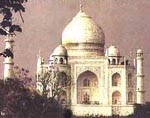 204 km.from
Delhi, lying on the river Yamuna, Agra, is famous the world over as the ‘City
of the Taj’.
204 km.from
Delhi, lying on the river Yamuna, Agra, is famous the world over as the ‘City
of the Taj’.
THE TAJ MAHAL : One of the seven wonders of the world,built by Emperor
Shah Jehan in memory of his beloved consort Mumtaz Mahal, this beautiful musoleum is pure
white marble and an architectural marvel. The Taj moonlight is a breath- taking sight.
AGRA FORT : Built by Emperor Akbar, the maze of courtyards, mosques and private chambers of the fort echo the story of the Mughal Empire. Moti Masjid, Jasmine Tower and Itmad-ud-Daulah reflect the skills of the ancient Indian architects and artists.
SIKANDRA : The tomb of Akbar the Great, built in red sandstone inlaid with marble is a striking sight.
FATHEHPUR SIKRI : The deserted city of Emperor Akbar literally means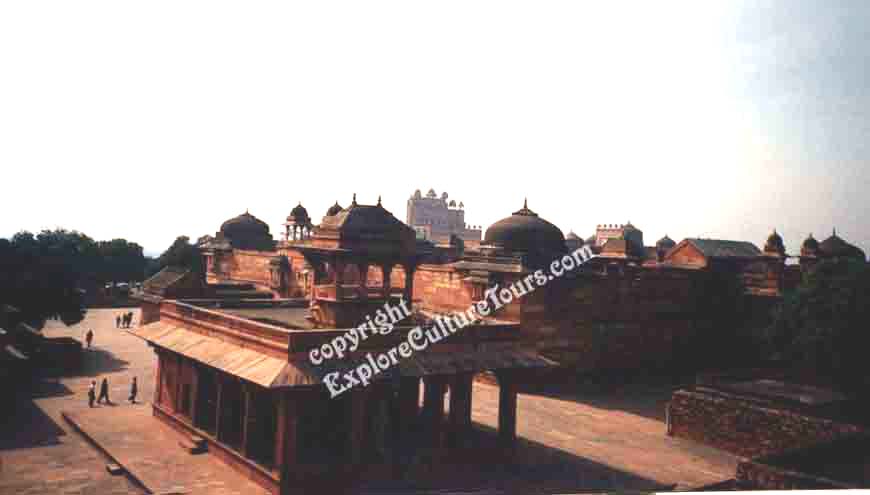
"The City of Victory"
The audience halls, palaces, and the mosques are still
in a state of perfection
as are the tomb of Sheikh Salim Chisti,
Panchmahal and the Buland Darwaza.
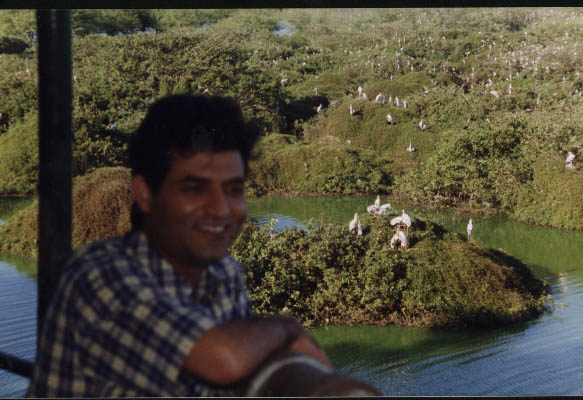 BHARATPUR (GHANA) BIRD
SANCTUARY : With in motorable distance of Agra,
Ghana is one of the best bird sanctuaries in India. Waterbirds assemble here during the
months of July/August and breed till October. The openbill stork, egret darter, white
ibis, spoonbill and heron are some of the birds seen here. Also found are Chital, black
buck, deer and other varieties of animals.
BHARATPUR (GHANA) BIRD
SANCTUARY : With in motorable distance of Agra,
Ghana is one of the best bird sanctuaries in India. Waterbirds assemble here during the
months of July/August and breed till October. The openbill stork, egret darter, white
ibis, spoonbill and heron are some of the birds seen here. Also found are Chital, black
buck, deer and other varieties of animals.
MATHURA-VRINDAVAN : A 45 minute drive from Agra and one of the oldest towns situated on the bank of the river Yamuna. Mathura is situated with places of pilgrimage connected with Lord Krishna. Throughout the year, devout pilgrims visit this place. The marble galleries adjoining the ghats are of great elegance. In ancient times Mathura was an important centre of the Hindu, Budhist and Jain faiths. The museum has one of the finest collections of sculptures, terra-cottas and inscriptions. It is closed on Mondays, but remains open on Holi, Janamashtami, Dussehra, Diwali and other holidays and shall be closed on the following day. Ten kilometers (6 miles) from Mathura is Vrindacan, a town of temples with some of the most magnificient shrines in North India.
| AHMEDABAD |
 Standing on the river Sabarmati, Ahmedabad, one
of the industrial centres of Western India, ranks high among the cities of India for its
architectural remains. Its places, mosques and tombs, are perfect specimens of
Indo-Saracenic architecture in Gujarat. The JUMMA MASJID, famous for its pictured
porticoes resting on 250 columns, is one of the most beautiful mosques in the East. Nearby
are the Teen Darwaza (Three Gateways) carved in sandstone. SIDDI SAYYAD’S MOSQUE is
world renowned for its intricate lattice-work of rich and elaborate design. The SWAYING
MINARETS - actually vibrate in unison and represent a feat in architectural skill. The
famous Sabarmati Ashram founded by Mahatma Gandhi; and the Rani Sipri Mosque is another
building of outstanding merit, renowned for its finely carved balconies. NAL SAROVAR BIRD
SANCTUARY has a variety of aquatic birds. One can also enjoy a boat ride on the lake.
MODHERA is famous for the Sun God Temple built in 1025 A.D. The unique feature of this
temple is that the rising sun at the equinoxes shines straight into the shrine
illuminating the image of the Sun God. The temple also has exquisite sculptures, scalloped
arches and tiered columns.
Standing on the river Sabarmati, Ahmedabad, one
of the industrial centres of Western India, ranks high among the cities of India for its
architectural remains. Its places, mosques and tombs, are perfect specimens of
Indo-Saracenic architecture in Gujarat. The JUMMA MASJID, famous for its pictured
porticoes resting on 250 columns, is one of the most beautiful mosques in the East. Nearby
are the Teen Darwaza (Three Gateways) carved in sandstone. SIDDI SAYYAD’S MOSQUE is
world renowned for its intricate lattice-work of rich and elaborate design. The SWAYING
MINARETS - actually vibrate in unison and represent a feat in architectural skill. The
famous Sabarmati Ashram founded by Mahatma Gandhi; and the Rani Sipri Mosque is another
building of outstanding merit, renowned for its finely carved balconies. NAL SAROVAR BIRD
SANCTUARY has a variety of aquatic birds. One can also enjoy a boat ride on the lake.
MODHERA is famous for the Sun God Temple built in 1025 A.D. The unique feature of this
temple is that the rising sun at the equinoxes shines straight into the shrine
illuminating the image of the Sun God. The temple also has exquisite sculptures, scalloped
arches and tiered columns.
LOTHAL : Lothal is 47 miles (75 kms) from Ahmedabad where archeologists have uncovered the earliest known civilization of the sub-continent (3500 B.C.). This is a part of the bigger Harappan civilization found in Mohenjodaro and Harappa. The excavated portion reveals an ancient section complete with dockyard, streets, houses, underground drains and a well.
MT. ABU : An overnight trip away from Ahmedabad is Mt. Abu, a place of pilgrimage for the Jains. Amongst its main features are the famous Dilwara Temples (open from 12.00 hrs to 18.00 hrs), Nakki Lake and Sunset Point. Boating on the lake is another highlight. (For details see Mt. Abu city profile).
ALLAHABAD |
| The triveni Sangam (Triple Stream Confluence), where the Ganga, the Yamuna and the legendary Saraswat meet, is sacred for Hindus. Allahabad is therefore, of great religious importance. It was originally known as Prayag - "place of sacrifice:. Other interesting places in Allahabad are the University and the Anand Bhawan-ancestral home of late Pandit Jawaharlal Nehru. |
| AMRITSAR |
A
few miles within India’s north-western border is Amritsar, known for its Golden
Temple, the most sacred shrine of the Sikhs and the tank called "the pool of the
immortality". Ram Das, the fourth Sikh Guru, founded the city while excavating the
holy tank. Guru Arjun Dev built the Temple and Ranjit Singh, the Sikh ruler, enriched the
shrine and covered its dome with copper, overlaid with gold foil. The interior of the
temple contains fine filigree and gold-inlay work. The exterior walls are inlaid with
precious stones. Nearby is the Jallianwala Bagh, where during the British rule in India,
General Dyer opened fire on innocent people causing a massacre. The place is now a
national monument, its walls bear the bullet marks of this tragedy. Also visit the
beautiful Rambagh Gardens, Khalsa College, Glency Medical College, the Durgiana Temple and
Kashmir Emporium.
| ANDAMAN AND NICOBAR ISLANDS |
A land of aborigines, convicts and Burmese settlers, today these islands (223 in number) stretch over 500 miles of sea offering the jaded traveller some of the most spectacular sights on earth, with a unspoilt, albeit primitive charm all its own.
Take a look at the superb Anthropological Museum, Viper Islands, Wright Mayo Creek, Carbyne Cove Beach, Wonder Beach, Cinggo Islands, Madhuban and the Cellular Jail.
| AURANGABAD |
An hour’s journey from Bombay by air, Aurangabad is the most convenient point for visiting the world famous Ajanta and Ellora Caves, 106 kms and 29 kms distant respectively, from Aurangabad city. They are the most remarkable monuments of their kind in the world.
Other interesting sights in Aurangabad are BIBI-KA-MAQBARA, built by Emperor Aurangzeb as a tomb for his wife in imitation of the Taj Mahal; PANCHAKKI, an interesting water mill in which lies the tomb of a Muslim Saint; HIMROO factory-where beautiful handloom cotton and silk fabrics are produced.
DAULATABAD : 15 km (9 miles) northwest of Aurangabad. Daulatabad is renowned for
its thirteenth century fortress, which has been a stronghold of rulers of the Deccan. In
1338, Delhi’s eccentric Sultan, Mohammed Tughlaq, made it his Capital. The Chini
Mahal, the Baradari and Chand Minar are some of the notable monuments.
| Ellora & Ajanta Caves |
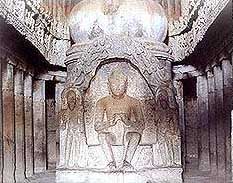 ELLORA CAVES: consists of temples and monasteries hewn from rock by Buddhists,
Hindu and Jain monks and craftsmen. They tell the story of the evolution of these three
religions. Over 2000 years old, they have been compared to the Pyramids for their amazing
construction, sculptures and frescoes. The most marvellous of all is the stupendous rock
temple of Kailash.
ELLORA CAVES: consists of temples and monasteries hewn from rock by Buddhists,
Hindu and Jain monks and craftsmen. They tell the story of the evolution of these three
religions. Over 2000 years old, they have been compared to the Pyramids for their amazing
construction, sculptures and frescoes. The most marvellous of all is the stupendous rock
temple of Kailash.
AJANTA CAVES: consists of 24 monasteries and 5 temple, again hewn out of solid rock. The wall paintings and frescoes of these caves have a beautiful flow of line and a wealth of colour.
| BANGLORE |
The capital of Karnataka state is the
Garden City of India. The Lalbagh Garden is particularly beautiful and well laid out. It
has one of the largest collections of exotic Indian tropical abd sub-tropical lakes and
quiet lotus-filled pools. Cubbon Park, Bull temple, Mysore Arts and Crafts Centre. Indian
Institute of Science and Commercial Street are worth visiting.
SRIRANGAPATNAM : The summer palace of Tipu Srirangapatnam is known for its
fortress and tomb of the famous Warrior King. It can be visited enroute to Mysore.
SOMNATHPUR TEMPLE : This temple is dedicated to Shiva and is a marvellous example of
Hoysala architecture with exquisite sculptures.
BELUR : Famous for the Chennakeswara temple, one of the finest specimens of Hoysala temple architecture of the 13th century with numerous carvings.
HALEBID : The elaborately carved temples of Hoysaleswara and Kedarswara are to be found here.
| BHOPAL |
Half hidden among mountains and nestling in rich foilage, Bhopal lies in the heart of Malwa and is the capital of the state of Madhya Pradesh. It is hallowed by memories of the great Hindu King - Raja Bhoj. It was also once renowned as a prominent centre is Buddhist culture. An outstanding feature of Bhopal are its two picturesque lakes. The sunset on the lakes and a view of the festive citylights from the two high points of Idgah and Shamla are a must for every tourist. City sightseeing includes Sadar Manzil, Jama Masjid, Taj-ul-Masjid, Taj Mahal Secretariat, Vidhan Sabha, Fatehgarh Fort, Moti Masjid, Tagore Memorial, National Archives of India and T.T. Nagar etc.
SANCHI : Sanchi is an important centre of Buddhist pilgrimage. The great Stupa, built by King Ashok (who abandoned war and embraced the Buddhist faith), is a grey-brown hemisphere and massive proportions. The form of the four gateways guarding the stupa is derived from bamboo fences. They are carved with scenes from the Buddha’s life and previous incarnations and are amongst the finest specimens of early Buddhist art.
UDAIGIRI CAVES : Situated about 12 kms form Sanchi, these are two Jain and eighteen Hindu caves. Cave No. 5 is a particularly famous for its representations of the Boar incarnation of the God Vishnu.
KHAJURAHO : For details see Khajuraho.
BHUTAN |
A colorful mountain state, the land of the Thunder
Dragon is a land of breathtaking scenery, mountains and peaks, monasteries and temples,
bazzars full of local colour, festivels of quaint charm. Trips to the Paro Valley, Kyichu
- Lakhang. Drukayal Dzong, Taktsang Monastery, Museum and Simtokha Monastery are included
in the sightseeing. Bhutan is also an excellent trekking country.
| BOMBAY |
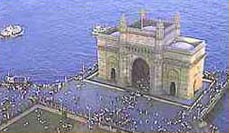 A beautiful harbour studded with hilly islands and a palmfringed shore, rising
gradually to the peaks of mountain ranges, form a fine waterfront for Bombay, the
"Gateway of India". Besides being the major port of India, Bombay is also a
great industrial centre. A cosmopolitan city, it owes its prosperity to the industry and
enterprise of its population of about eight million. It is the commercial captial of
India.
A beautiful harbour studded with hilly islands and a palmfringed shore, rising
gradually to the peaks of mountain ranges, form a fine waterfront for Bombay, the
"Gateway of India". Besides being the major port of India, Bombay is also a
great industrial centre. A cosmopolitan city, it owes its prosperity to the industry and
enterprise of its population of about eight million. It is the commercial captial of
India.
The major sights in the city are the Gateway of India - a 262 feet high gateway, overlooking the sea, built to commemorate the visit of King George V. and Queen Mary in 1911; Dhobi Ghat; Tata Institute; Rajabai Clock Tower and the High Court in the Gothic architectural style; Marine Drive (also known as "Queen’s Necklace", the street lights shining like jewels at night), the Aquarium; Kamla Nehru Park, Hanging Gardens, Mahalaxmi Temple; Haji Ali’s Tomb; Mani Bhawan; Crawford Market; Victoria Terminus; Flora Fountain and the Prince of Wales Museum. (The Aquarium and Museum are closed on Mondays, Independence Day - August 15 and Republic Day - January 26).
JUHU BEACH : About 20 kms from Bombay is a popular seaside bathing spot - Juhu Beac. People from downtown have built weekend homes here and shacks are available on short or long term leases.
ELEPHANTA : Six miles (10 kms) across Bombay harbour is a small island called Elephanta or ‘Gharpure’. It contains a fine cluster of 6th - 8th century rock-cut caves. They were carved during the Golden Age of the Guptas and inspired by the worship of Shiva. The sculptures are beautifully executed and the most outstanding of these is the Maheshmurthy or Trimurthi (Triple Face), a 4.5 meter (18 ft) high three-headed bust hewn from a single rock, representing the triple aspects of Shiva, viz, the Creator, the Preserver and the Destroyer.
AAREY MILK COLONY : About 32 kms from Bombay, this is one of the most modern dairies in Asia. There is an observation post on a hill near the entrance, a fine place for a picnic. A round trip includes Juhu, Aarey Milk Colony, National Park, Lake District and Kanheri Caves.
KARLA AND BHAJA CAVES : Situated near the scenically interesting towns of Lonavala and Khandala, on the Bombay - Poona National Highway, Karla caves are cut out of solid rock of the Deccan Plateau. They were dedicated in 80 B.C. by Hinayana Buddhist monks. Giant steps lead past a waterfall to the main cave which has a large chaitya or prayer hall carved out of the rock. The pillars, the ribbed vaulting and the animal sculptures are particularly interesting.
| CALCUTTA |
SHANTI NIKETAN : Shanti Niketan or the abode of peace is the name chosen by Rabindranath Tagore for the site of the Vishwa Bharti University - a university conceived to be a place where the whole world meets. Founded on idealism, it has a district atmosphere. Classes are conducted under the shade of trees and great emphasis is placed on the fine arts. There are facilities for the study of Comparative Religions, Philosophy, Chinese and Indian classics and the fine arts. It attracts students from all over India and overseas.
CHANDIGARH-NORTH India |
An obscure village in 1947, Chandigarh is today a famous name in architecture and town planning. Planned by a team of renowned architects, led by the famous French architect, Le Corbusier, Chandigarh represents an ideal combination of what is best in the architecture of India and the West. Visits include the Secretariat, High Court, State Library, Assembly Chambers, Rose Gardens and the Lake. A short distance away are the Pinjore Mughal Gardens.
BHAKRA NANGAL PROJECT : In a gorge of the green Shivalik hills, is situated India’s most ambitious multi-purpose river valley project, the Bhakra Nangal Dam. It consists of 226 metre high Dam at Bhakra across the Sutlej River. The Bhakra Dam presents an impressive sight and is regarded as an engineering feat. The Project designed to irrigate 4 million acres of farmland in the Punjab and Rajasthan, has a capacity to generate 450,000 kilowats of electricity. The Nangal Fertilizer Plant is also worth visiting, (Special permission is necessary).
SIMLA : Situated against dark green ranges about 2214 m (7,262 ft) above sea level, this one-time summer capital of the Government of India, is now the capital of Himachal Pradesh. The 100 km journey has a romance of its own, the mountain road winding through terraced fields, fine forests and rhododendron trees. Winter sports are held every year at Kufri, 16 km (10 miles) from Simla. Simla is the point of origin of many interesting treks.
| COCHIN |
Cochin, originally built by the Portuguese, has a natural harbour with lagoons and canals and fishing hamlets. One of the three biggest ports on the West Coast, it is also an industrially developed area. The coin industry is of special importance. There is golf and swimming for the sporty tourist. An excursion by the backwaters is enchanting.
Sightseeing includes visits to the Cochin Harbour Terminus, Mattancheery Dutch Palace (closed on Mondays and National Holidays), Jewish Synagogue (Closed on Saturdays), Jew Town, Fort Cochin Area - St. Francis Church (Closed to visitors on Sunday from 8.30 hrs to 13.30 hrs), Chinese Fishing Nets. Also at Ernakulam, the Public Gardens, Colleges, High Court Building and Broadway Shopping Centre.
KOTTAYAM EXCURSION : A full day trip by motor launch to Kottayam, to visit old churches especially the Syrian Church. One can return by road driving through tropical fields and charming countryside.
PERIYAR WILDLIFE SANCTUARY : Periyar is spread out over an area of 300 sq. miles and one can see leopard, tiger, elephants, bison and wild bear. An overnight trip from Cochin enables one to take a recommended early morning boat ride on Periyar Lake to view wildlife and waterbirds.
| COIMBATORE |
The traditional city of temples and worship of beauty and peace. Make trips to the Botanical Garden, Lord Murgan’s birth place. A short distance away is the beautiful hill station - Coonoor. Lady Canning Seat, Sim’s Park, Pasteur Institute, Tiger Hill, Walker Hill, Love Dale and Lambs Rock.
| CHITTAGONG |
Home of some of the greatest pre-partition revolutioneries, Chittagong today is the main port of Bangladesh. See the Shahi Jama Mosque, Sadam Mubarik Mosque, the tomb of Sultan Bayazid Bastani, the Dargah of Shah Amanat. Paharall Lake and the Beaches of Patenga and Fouzdar Hat. A short distance away lies Kaptal, the largest man-made lake in the sub-Continent, abounding in wild life.
Also Rangamati, district headquarters of Chittagong hill tract, ablaze with flora and fauna.
| COX’S BAZAR |
Bangladesh’s pride - yesterday’s popular shopping centre for the fashionable westerner. Today it boasts of having the world’s largest stretch of beach.Enjoy the Irani and Hamchari beaches for natural surroundings. Also the small islands of Nila Moheskali and Sonadia.
| DACCA |
Today’s capital of independent
Bangladesh was yesterday’s East Pakistan; day-before’s East Bengal.
Glimpse the Suharwardy Uddyan (from where the Late President Mujibur Rehman gave the call
for freedom). Shahid Minar, Gono Bhavan, Banga Bhavan, Lalbagh Fort, Museum the Tomb of
Pari (Fairy Bibi).
| DARJEELING |
With its forest glades ablaze with rhododenndrons in early summer, quaint villages and interesting hillfolk - Lepchas, Bhutias, Tibetans and Nepalese - thronging its bazzars, Darjeeling has its own charm.
Sightseeing covers Lebong Village which has the highest race course in the world, Mountaineering Institute. House of Tensing Norgay - the Everest Hero and the Botanical Gardens. Also Tiger Hill where the early morning sun displays a panaroma of colours and the sunsets are purple and gold. Beyond in the distance are the Himalayan peaks and the famous Kanchenjunga. Return via the Ghoom monastery.
KALIMPONG : 52 km (32 miles) from Darjeeling at an altitude of 1219 m (4000 ft) lies Kalimpong, famous for its arts and crafts and for its Buddhist monastery. The journey to Kalimpong from Darjeeling is picturesque. An ideal place for a quiet holiday, where Bhutias and Tibetans trade their wares at the Central Market Square.
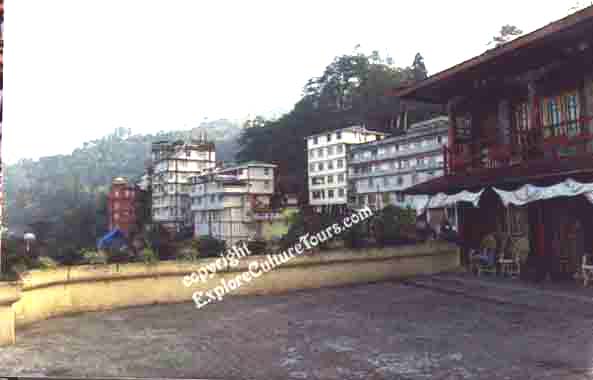 GANGTOK : The road from Darjeeling to Gangtok is via Rangpotonen in the
Tista Valley. It meanders along the river Tista and reaches Singatam. Then once again
through the forests and open mountain side on the serpentine road, to get one’s first
view of Gangtok, the capital and principal town of Sikkim, tucked away in the clouds,
spread out on a ridge, 5000 ft above sea level. This tiny town at first glimpse, looks
like something out of a fairytale with houses which seem precariously balanced on the
slopes of the steep mountain hills. Apart from gorgeous views of deep valleys, and the
snowcapped mountain ranges, Gangtok has a number of places of interest to offer to the
visitor, namely, the Research Institute of Tibetology, Garden Sanctuary, Buddhist
Monastery (attached to the Palace), the Residency - a house for the Political Officer of
the Government of India - an excellent view of the mountains can be had from this point.
Also see the Deer Park and take a drive through the colourful bazzar.
GANGTOK : The road from Darjeeling to Gangtok is via Rangpotonen in the
Tista Valley. It meanders along the river Tista and reaches Singatam. Then once again
through the forests and open mountain side on the serpentine road, to get one’s first
view of Gangtok, the capital and principal town of Sikkim, tucked away in the clouds,
spread out on a ridge, 5000 ft above sea level. This tiny town at first glimpse, looks
like something out of a fairytale with houses which seem precariously balanced on the
slopes of the steep mountain hills. Apart from gorgeous views of deep valleys, and the
snowcapped mountain ranges, Gangtok has a number of places of interest to offer to the
visitor, namely, the Research Institute of Tibetology, Garden Sanctuary, Buddhist
Monastery (attached to the Palace), the Residency - a house for the Political Officer of
the Government of India - an excellent view of the mountains can be had from this point.
Also see the Deer Park and take a drive through the colourful bazzar.
| DELHI |
The old city, built by Shah Jehan in the 17th century, stands today as an epitome of the whole history of Indo-Islamic architecture. New Delhi, designed and constructed by Sir Edwin Lutyens and Sir Herbert Baker is a mixture of east and west. The public buildings in red sandstone are in the Moghul style. It has a circular Parliament House and an imposing Central Secretariat in two blocks which stand at the approaches to Rashtrapati Bhavan, the residence of the President of India. Delhi is today the political, economic and cultural capital of the world’s largest democracy and has also become one of the greatest tourist centres of the world.
SIGHTSEEING OF OLD DELHI : Visit Jamma Mosque (1650 A.D.) and drive through fabled Chandani Chowk (Moonlight Square), the main area of the old city. Visit the Red Fort (1639-48 A.D.), built by the builder of the Taj Mahal - Shah Jehan, and famous for its delicately carved, inlaid and marbled Royal Chambers; Raj Ghat, where the father of the nation, Mahatma Gandhi, was cremated (1948 A.D.); Gandhi Memorial Museum (Closed on Mondays); Feroze Shah Kotla (1354 A.D.) - ruins of the old fortress and also the Ashok Pillar (330 B.C.).
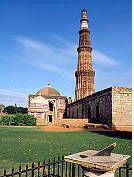 SIGHTSEEING OF NEW DELHI : Visit Humayun’s Tomb (1565 A.D.), aptly called predecessor of the Taj Mahal.
Drive past Safdarjang’s Tomb (1753 A.D.), the Qutb Minar, 72 metres high and one of
the perfect towers of the Persian world. Nearby, amidst the ruins of the Quwut-ul-Islam
Mosque stands the Iron pillar which has stood the vagaries of the weather and not rusted
over 1500 years. An orientation drive through New Delhi includes the Embassy area
(Diplomatic Enclave), Govt. Building (1921-30 A.D.) and Birla (Laxmi Narayan) temple (1938
A.D.). Drive past Jantar-Mantar Astronomical Observatory (1717 A.D.) and through
Connnaught Place, New Delhi’s main shopping centre.
SIGHTSEEING OF NEW DELHI : Visit Humayun’s Tomb (1565 A.D.), aptly called predecessor of the Taj Mahal.
Drive past Safdarjang’s Tomb (1753 A.D.), the Qutb Minar, 72 metres high and one of
the perfect towers of the Persian world. Nearby, amidst the ruins of the Quwut-ul-Islam
Mosque stands the Iron pillar which has stood the vagaries of the weather and not rusted
over 1500 years. An orientation drive through New Delhi includes the Embassy area
(Diplomatic Enclave), Govt. Building (1921-30 A.D.) and Birla (Laxmi Narayan) temple (1938
A.D.). Drive past Jantar-Mantar Astronomical Observatory (1717 A.D.) and through
Connnaught Place, New Delhi’s main shopping centre.
Garhwal Himalayas |
The
land of infinite mountain lakes, a Pandora box floral scapes,
teeming
fauna, icon of celestial radiance… Garhwal is the most picturesque postcard come
alive. Known as ' Abode of the Gods' , Garwhal is indeed a pleasure to discover. If Kumaon
is a Himalayan jewel, Garhwal is the pride of the Himalayas.
The
sacred places of Badrinath, Kedarnath, Gangtori & Yamunotri are located here and so
are the sources of the most venerated rivers Ganga and Yamuna. The legendary valleys of
Garhwal abound with natural beauty and also offer a distict style of hill temple
architecture and delightful handicrafts.
For
entering Garhwal the last railheads are Dehradun, Kotdwar and Rishikesh. Some important
trains connecting Dehradun to other parts of the country are Ujjaini Express,
Bombay-Dehradun Express, Varanasi-Dehradun Express, Howrah-Dehradun Express, Shatabadi
Express, Mussoorie Express, Dehradun- Allahabad and many more.
Garhwal
has been described as the most beautiful land in the mountains of the Asian subcontinent
by Dr. T.L. Longstaff, world renowned mountaineer, naturalist and trekker.
GOA (PANJIM) |
 This
former Portguese Colony is a picturesque land full of scenic charm and many attractions
such as historic forts, elabortately ornate churches and temples, evergreen hills and
mountains, winding rivers and creeks, fields and particularly, the palm-fringed pearly
white beeches which leave any visitor spellbound. The most famous churches are in Old Goa,
8 kms from the capital city of Panjim. The sacred remains of the patron of the East, St.
Francis Xavier, lie enshrined in the Basilica of Bom Jesus and have made Goa famous as the
‘Rome of the East’.
This
former Portguese Colony is a picturesque land full of scenic charm and many attractions
such as historic forts, elabortately ornate churches and temples, evergreen hills and
mountains, winding rivers and creeks, fields and particularly, the palm-fringed pearly
white beeches which leave any visitor spellbound. The most famous churches are in Old Goa,
8 kms from the capital city of Panjim. The sacred remains of the patron of the East, St.
Francis Xavier, lie enshrined in the Basilica of Bom Jesus and have made Goa famous as the
‘Rome of the East’.
The most famous beaches along Goa’s 100 km long coastline are Gasper Dias, Callangute, Colva, Bogmalo and Vagator. These beaches attract thousands of visitors every season, when this luscious territory is turned into a veritable playland, full of colour, fruit, music, delicious food, fun and frolic.
The capital of Goa, Daman and Diu, Panjim is a small, but charming city on the banks of the river Mandovi, with an individuality and architectural grandeur of its own. A number of modern houses, fine gardens and statues add to the charm of the capital, which makes it even more picturesque from the top of the Altinho hill.
SIGHTSEEING : Panjim, Altinho, Dona Paula - a notable landmark, from where one can have an excellent view of India’s largest natural harbour and the lush vegetation, Gasper Dias Beach and on to Old Goa to see the Basilica of Born Jesus where the body of St. Francis Xavier is enshrined in a silver casket, the Cathedral of St. Catherine, etc.
CALANGUTE BEACH : 15 kms from Panjim, this is the most popular beach in Goa and attracts thousands of visitors every year and is known as the ‘Queen of Goa Beaches’.
| GWALIOR |
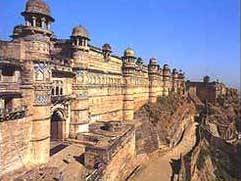 Gwalior
has played a great role in the history of India and it is described as a pearl in the
necklace of the castles of India. It derives its name from St. Gwalipa. Formerly the
capital of Madhya Bharat, it was ruled by Tomar Kings, Mughals and Marathas. During the
Indian Independence struggle in 1857. Gwalior plaayed an important part under the
leadership of Rani Laxamibai of Jhansi. There are a number of places which will be of
great interest to the tourist with an archeological interest.
Gwalior
has played a great role in the history of India and it is described as a pearl in the
necklace of the castles of India. It derives its name from St. Gwalipa. Formerly the
capital of Madhya Bharat, it was ruled by Tomar Kings, Mughals and Marathas. During the
Indian Independence struggle in 1857. Gwalior plaayed an important part under the
leadership of Rani Laxamibai of Jhansi. There are a number of places which will be of
great interest to the tourist with an archeological interest.
Sightseeing includes visits to the great Fort, one of the oldest in India, situated on an isolated hill of sandstone, 300 ft above the plain; Man Mandir, a sex towered palace which forms the eastern wall of the Fort and one of the classic sights of India; Gujari Mahal, a turreted palace of stone and now the home of an archeological museum. Outside the Fort is the tomb of Mohammed Ghaus, a Muslim saint worshipped by the Moghuls as well as the tomb of the famous musician Tansen.
SHIVPURI : 113 kms (70 miles) by road from Gwalior, among green hills, lakes and waterfalls is the summer resort of Shivpuri, at an altitude of 1,400 ft. There is an exquisite memorial in marble with beautiful inlay work. The national park around Shivpuri abounds in big game such as tiger, bear, sambhar, blue bull, spotted deer and also duck, geese, jungle fowl, patridge, green pigeon and peacock.
| HARDWAR / RISHIKESH |
Visit Har-ki-Pauri, the famous bathing Ghat, Canal Centenary Bridge, Lalta Rao Bridge, Sapt Rishi Asharam, Daksh Mahadev Temple, Gurukul and Kangra University. At Rishikesh, Bharat Temple. Triveni Ghat, Lakshman Temple, Laxman Jhoola, Swarga Asharam and Geeta Bhavan.
| HYDERABAD |
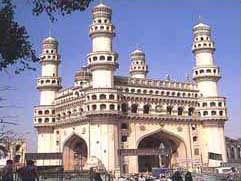 Once the
Nizam’s capital, now the capital of Andhra Pradesh, Hyderabad has long been a centre
of Muslim learning and culture. The city’s architecture has a strong Persian flavour.
In the heart of the city stands the graceful Char Minar (Four Minarets) synonymous with
Hyderabad. The principal mosque in the city is the Mecca Masjid which can accommodate
10,000 worshippers at a time. The Salar Jung Museum, a rare instance of individual
enterprise in the sphere of art collection, has fine jewellery, precious stones,
paintings, wood and metal carvings, Chinese porcelain, art objects, manuscripts,
curiosities and some remarkable pieces of furniture.
Once the
Nizam’s capital, now the capital of Andhra Pradesh, Hyderabad has long been a centre
of Muslim learning and culture. The city’s architecture has a strong Persian flavour.
In the heart of the city stands the graceful Char Minar (Four Minarets) synonymous with
Hyderabad. The principal mosque in the city is the Mecca Masjid which can accommodate
10,000 worshippers at a time. The Salar Jung Museum, a rare instance of individual
enterprise in the sphere of art collection, has fine jewellery, precious stones,
paintings, wood and metal carvings, Chinese porcelain, art objects, manuscripts,
curiosities and some remarkable pieces of furniture.
Among the most recent buildings in the city are the Falaknuma Palace and the Osmania University. The public Gardens, one of the largest of India’s botanical gardens, also house the Town Hall, the Museum and the Jubilee Hall. City sightseeing includes visiting Public Gardens, Archeological Museum, Gandhi Bhavan, Mecca Masjid, Char Minar, Osmania Hospital, High Court, State Library, Lal Bazzar, (famed for its glass bangles and pearl ornaments) Salar Jung Museum (closed on Fridays) and Abid Road, the city’s shopping centre.
GOLCONDA : The ancient fort of Golconda, 10 kms west of Hyderabad, stands on the summit of a conical hill encircled by a crenellated granite wall with 76 bastions. The famous diamond - Kohinoor - is believed to have come from Golconda, famous in history for diamonds from the neighbouring mines.
OSMAN SAGAR AND HIMAYAT SAGAR : Two picnic spots about 161 kms (100 miles) from Hyderabad. Enroute is Nizam Sagar, one of the biggest lakes in India covering 129 sq. km. (50 sq. miles) in area.
NAGARJUNACONDA : On the right bank of the Krishna river is Nagarjunaconda, named after a famous Buddhist scholar of the 2nd Century A.D. It attracted pilgrims like the Chinese Huen Tsang from abroad. The Buddhist scupltures at Amaravati and Nagarjunaconda also atttact art lovers. Remains of stupas and monasteries and a university were discovered here, proving it to be a centre of Buddhist culture. Indian archaeologists have saved these ruins and they have been lifted to a beautiful islands museum in the middle of the lake.
| INDORE |
The country’s fourth largest textile center - Indore was also one of the first places to join Mahatma Gandhi’s campaign towards providing the Harijans with a better way of life.
Tour Kanch Mandir, a Jain shrine worked in glass mother-of-pearl and glass beads. Lalbagh Palace and New Palace.
A little distance away lies Mandu, famed for its Jumuna Masjid, Jahaz Mahal and Hindola Mahal.
| JAIPUR |
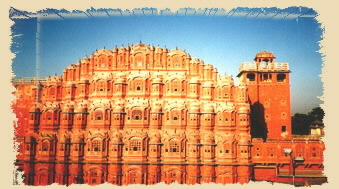 The rose-pink capital of
Rajasthan, is surrounded on all sides by rugged hills, crowned with forts. Enclosed
by embattled walls, the city was built early in the eighteenth century. The
Maharaja’s palace stands in the centre of the city amidst lovely gardens. Houses with
latticed windows line the streets, their rose-pink colour lending enchantment to the scene
and almost magical at sunset. Jaipur is aptly called the "Pink City of India".
It takes its name from the famous Maharana Sawai Jai Singh, who founded the city in 1728.
A keen astronomer, he built an observatory which still exists and is equipped with quaint
masonry instruments of remarkable size.
The rose-pink capital of
Rajasthan, is surrounded on all sides by rugged hills, crowned with forts. Enclosed
by embattled walls, the city was built early in the eighteenth century. The
Maharaja’s palace stands in the centre of the city amidst lovely gardens. Houses with
latticed windows line the streets, their rose-pink colour lending enchantment to the scene
and almost magical at sunset. Jaipur is aptly called the "Pink City of India".
It takes its name from the famous Maharana Sawai Jai Singh, who founded the city in 1728.
A keen astronomer, he built an observatory which still exists and is equipped with quaint
masonry instruments of remarkable size.
Jaipur is noted for its craftsmen skilled in the art of cutting precious stones and famed for its garnets and rubies. It is equally well known for brass inlay work, lacquer work and the printing of muslims.
CITY SIGHTSEEING : The City Palace which now houses a museum containing rare manuscripts, painting and an armoury; the Observatory - built in the 17th century by Jai Singh - with a sundial 90 ft. high; the Museum amidst the Ram Niwas Palace Gardens founded in 1876 with a large collection of antiques; the Palace of Winds, a landmark of Jaipur made of pink sandstone and of unique design. Drive around the Pink city.
AMBER : 12
kms (7 miles) from Jaipur, lies Amber with an old palace overlooking the lake at the
entrance to a rocky mountain grove. Built in the 17th century, the palace is a
distinguished specimen of Rajput architecture. The Jai Mandir (Hall of Victory) is so
delicately ornamented with fine inlay work that it glows. The fort of Jaigarh, crowning
the summit of a peak is of amazing beauty and grandeur, (Amber Palace and Observatory will
remain closed on 26th January, 15th August, 2th October and the day following the Festival
of Holi in March). Take a joy ride on elephant back to Amber Fort.
SARISKA : Rajasthan’s
outstanding sanctuary rich in wildlife. Sariska possesses great scenic beauty and the
wildlife consists of sambhar, four-horned antelop, wild boar, spotted deer, chinkara,
hyena, porcupine and rabbit. Tiger and leopard are common and can be conveniently seen
from observation towers. For bird watchers, the sanctuary is even more interesting as
partridge, quail, sandgrouse, peacock and green pigeon move freely on the roads. There is
a Forest Rest House as well as a Palace Hotel. (Best period - October to June.)
JODHPUR |
MANDORE : About 8 kms to the north of Jodhpur is Mandore, the old capital of Marwar, abandoned for strategic reasons. The gardens at the foot of the hill have commemorative cenotaphs of the former rulers of Jodhpur. The shrine of 330 million gods is an interesting sight. In the hall of Heroes, is a group of colossal figures carved out of a single rock.
OSIAN : 67 kms (42 miles) from Jodhpur towards the north-west, Osian has 16 Jain and Vaishnava temples dating back from 8th to 11th centuries presenting the grandeur of Indian temple architecture. All the sixteen temples are within the outer limit of the village.
| KANHA |
KANHA NATIONAL PARK : One of the best places in India for viewing wildlife, Kanha is famous for swamp deer, bison, barking deer, sloth bear, etc. This park is specially known for tiger and chital. Other animals to be seen are leopard, hyena, gaur, black buck and pig. The bird life includes black Ibises, vultures and crested serpent eagle. Kanha is now a tiger reserve under Project Tiger. April to June, and again November to January are the ideal times to visit the Park.
| KATHMANDU |
Sightseeing includes visiting Hanuman Dhoka - historic seat of royalty, Temple of the Living Goddess, Kasthamandap, Machhendranath Temple, Pagoda Temple and Patan.
SWAYAMBHUNATH : Two miles west of Kathmandu, Swayambhunath is 2000 years old and one of the world’s oldest Buddhist Chaityas. Painted on the four sided base of the spire are the all-seeing eyes of Lord Buddha. It is very holy pilgrimage centre for Buddhists and Hindus alike.
PATANA : On a raised ground five kilometers south-east of Kathmandu stands the ancient city of Patan, full of gateways, guardian deities and endless carvings. Noted for its craftsmen and mental workers, it is known as the "City of Artists". Visits include Durbar Square, Hinayana Varna Mahavira, Krishna Mandir, Macchendranath Temple, Meri Nath Temple, The Ashoka Stupa and Tibetan Refugee Camp.
PASHUPATINATH : Five kms. from Kathmandu and dedicated to Lord Shiva this Pagoda style is situated on the bank of the sacred Bagmati river. It has a gilt roof and richly carved silver doors and is one of the holiest temples in the entire Hindu world. Pashupatinath is the centre of an annual pilgrimage on the day of Shivratri. Only Hindus are allowed to go inside the courtyard of the temple. Tourists can view the temple from eastern side of the Bagmati river.
BODHNATH : 8 kms, from Kathmandu, this colossal stupa, one of the biggest in the world, is built on an octagonal base. It too has the all seeing eyes of the Buddha inset with prayer wheels. The shrine is ringed by houses of the Goddess Mani Jogini and Lamas or Buddhist priests.
BHADGAON : Bhadgaon (Bhaktapur - "the City of Devotrees") is a centre of medieval art and architecture. The legendary city was founded by King Ananda Deva in 889 A.D. and is shaped like a conch-shell. Pottery and weaving are itsd traditional industries. Visit Durbar Square and Nyatapala Temple - a 5 storied pagoda style temple.
KAKANI : 6,500 ft. above sea level and 27 kms. from Kathmandu, the city overlooks the north-western Himalayan ranges,. Its attractions range from beautiful alpine scenery to the magnificient Himalayan Panorama, particularly of the Ganesh Himal massiff.
KIRTIPUR : A small town, eight kilometers from Kathmandu on top of a plateau shaped ridge. This historic town has much to offer - the Tribhuvan University, old shrines, temples, old houses, people dressed typically in old traditional costumes and working on ancient looms.
DAKSHINKALI : This temple is a place of pilgrimage dedicated to Goddess Kali, the deity to whom animals are sacrificed on Tuesdays and Saturdays. The Dakshinkali sanctuary is located approximately 45 minutes by car from Kathmandu city. The road leading to Dakshinkali is very picturesque.
DHULIKHEL : (5,000 ft.) A small quiet township on the Chinese built road that links Kathmandu to Lhasa (Tibet). From its flower covered hillsides, one of the most spectacular scenic views is visible, specially the sunrise and the sunset over the snowcapped mountain ranges.
Sunrise : (Winter - 4.30 a.m. to 8.00 a.m.)
(Summer - 4.00 a.m. to 7.30 a.m.)
NAGARKOTE : 22 miles east of Kathmandu and 7,133 ft. above sea level, Nagarkote is a round the year holiday resort. The major peaks of most of the eastern Nepal Himalayas including Sagarmatha (Mt. Everest) can be seen from here. Best at sunset and sunrise.
Sunrise : (Winter - 4.15 a.m. to 8.15 a.m.)
(Summer - 4.00 a.m. to 8.00 a.m.)
SIMBHANGYANG PASS : About 96 kms. each way, highest point 8,000 ft., on the highway to India. A breathtaking view of mountains including Mount Everest.
KODARI : The Kodari Road, also known as Chinese Road, was built with the financial and technical assistance of the People’s Republic of China, by Chinese and Napalese engineers. It links Kathmandu with the Chinese border and beyond that it continues upto Lhasa. This border point is reached by a thrilling 115 kms. drive through mountainous terrain. Kodari commands a fine view of the mountain peaks including Mount Everest.
POKHARA : The Pokhara Valley is one of the most picturesque spots of Nepal. The Lakes Phewa, Begnas and Rupa here have their source in the glacial region of the Annapurna range of the Himalayas. 203 kms. from Kathmandu, Pokhara is connected by air as well as a land rout.
| KAZIRANGA |
 430
kms in area, Kaziranga is the home of the great Indian one-horned rhinoceros. The animals
are seen at close proximity on elephant back. The wild buffalo, swamp deer, hog deer, the
black-necked stork, ring-tailed fishing eagles and other waterbirds are to be found at the
Jheels. A ‘jheel’ is a swampy flat with a broad pool of shallow water in the
middle, usually fringed with reeds and is typical of Assam.
430
kms in area, Kaziranga is the home of the great Indian one-horned rhinoceros. The animals
are seen at close proximity on elephant back. The wild buffalo, swamp deer, hog deer, the
black-necked stork, ring-tailed fishing eagles and other waterbirds are to be found at the
Jheels. A ‘jheel’ is a swampy flat with a broad pool of shallow water in the
middle, usually fringed with reeds and is typical of Assam.
One can see these animals as well as elephants and tigers in a wilder setting, deeper in at Baguri, Near Kaziranga village there is a pelicanry. There are motor roads in the sanctuary and riding elephants are available.
| KHAJURAHO |
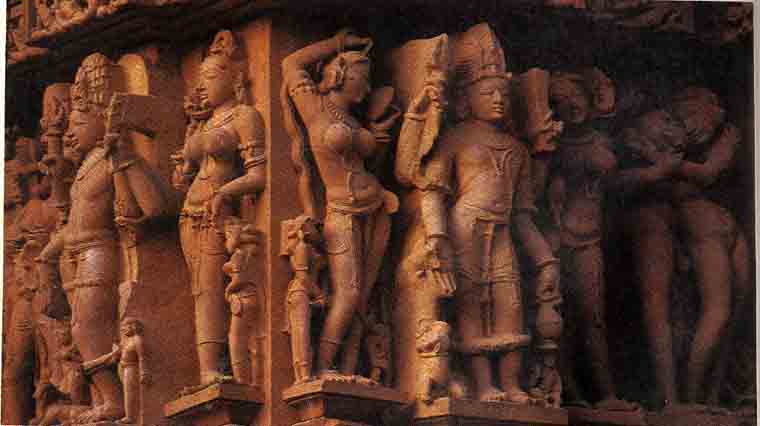 Khajuraho is known for its magnificient temples which are among the
most creative examples of Indian architecture. Built between 950 and 1050 A.D., only 22
temples out of 85 now survive. Khajuraho sculpture is sublime and sensuous, the centre of
new imagery in art. The popular theme is woman: reflective, playful, amorous. The carvings
also depict griffins, nymphs, beasts, demons in revolt, gods in cosmic evolution, fear,
doubt, jealousy, ardent love and consumate passion. The temples of Khajuraho can be
divided into three geographical groups-western, eastern and southern.
Khajuraho is known for its magnificient temples which are among the
most creative examples of Indian architecture. Built between 950 and 1050 A.D., only 22
temples out of 85 now survive. Khajuraho sculpture is sublime and sensuous, the centre of
new imagery in art. The popular theme is woman: reflective, playful, amorous. The carvings
also depict griffins, nymphs, beasts, demons in revolt, gods in cosmic evolution, fear,
doubt, jealousy, ardent love and consumate passion. The temples of Khajuraho can be
divided into three geographical groups-western, eastern and southern.
Sightseeing of Khajuraho: Visit the temples of Khajuraho which are world famous not only for their symmetry and design, but also for intricate and erotic carvings on their walls. The main temples are Kandariya Mahadeo, Chitragupta, Parsvanath and the Ghantai.
LUCKNOW |
| LADAKH |
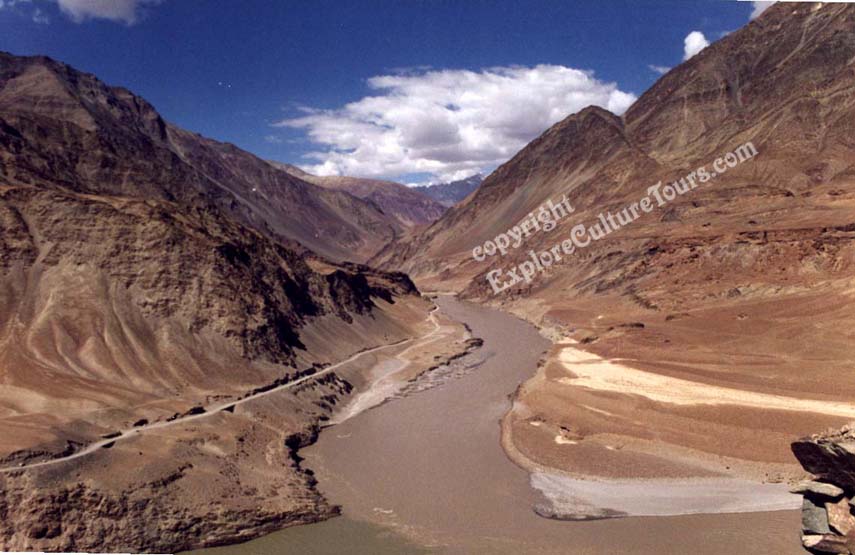 Sometimes referred to as "Moon Land", Ladakh derives its
name from "La Tags" in Tibetan. Enshrined in glorious history and abounding in
monastries, Ladakh is among the most beautiful places in the world - also among the most
elevated regions.
Sometimes referred to as "Moon Land", Ladakh derives its
name from "La Tags" in Tibetan. Enshrined in glorious history and abounding in
monastries, Ladakh is among the most beautiful places in the world - also among the most
elevated regions.
Discover for yourself the wonders of Nanga Parbat, Casharbrum, Masharbrum, Mt. Godwin Austin.
| MADRAS |
The gateway to the sunny south, the capital of Tamil Madu is also the seat of an ancient civilization, with a rich heritage of fine arts, sculpture and architecture. The city of Madras extends over an area of nearly 80 sq. kms. has a population of about two million and is the third largest city of India. It has withstood the pressure of modernization to some extent and even today retains an old-world charm which has an instant appeal for the visitor.
Sightseeing of Madras includes visiting the National Art Gallery and Museum, (closed on Fridays), Fort St. George, the Fort Museum, St. Mary’s Church, a drive along the Marina Beach, visit to the San Thome Cathedral, the Mylapore Temple and the Victoria Technical Institute.
| MADURAI |
Known as the City of Festivals, Madurai is the most ancient home of culture and the first Tamil Academy was founded here by scholars and pious kings. The town has developed encircling the famous Meenakshi Temple built in the Dravidian style - one for Shiva and the other for his spouse Meenakshi. It is believed that if you place a literary work in the tank of this temple, it will sink if it is worthless and float, if worthy. The temple has beautiful sculptures of Shiva. The court of thousand pillars was built in 1560 A.D. Here also there are lovely sculptures. From any side the hall, the visitor can get a kaleidoscopic view. Outside are the Musical Pillars which produce different swaras or notes when tapped outside the temple. To the east is the Vasanth Mandapam with life size statues of nayakas of Madurai.
Sightseeing of Madurai includes visits to Teppa Kulum (Mariamman) a tank with an Island Temple. Tirumalainaik Palace, 1000 pillared hall and the Meenaakshi Temple and a general sightseeing of the city to view local colour.
| MALDIVES |
A string of shimmering pearls, sprinkled along the dazzling blue waters of the Indian Ocean, the Maldive Islands are a chain of 2000 coral islands grouped in small close clusters, 400 miles south-west of India.
| MYSORE |
This "Garden City" stands by a rocky hill named after the goddess Chamundi. It is a city of palaces and museums. The palace of the Maharaja within the Old Fort is admittedly one of the most beautiful buildings in India. The best time to visit Mysore is during the Dussehra festivities which are observed with pomp and pageantry for ten days in September/October. Sightseeing of Mysore City includes a visit to the Gardens, the Zoological Gardens, Mysore Arts and Crafts Centre, the beautiful Brindavan Gardens illuminated during the weekends, and the Chamundi Temple overlooking the city.
The Brindavan Gardens have been laid out by the side of the Krishnarajasagar Dam with beautiful lawns and beds of flowers, fragrant shrubs, cascades and fountains.
BANDIPUR WILDLIFE SANCTUARY : The sanctuary is situated on the Mysore-Ooty road. The original sanctum sanctorum of the much larger Venugopal National Park, Bandipur is now being expanded under Project Tiger. It adjoins Tamil Nadu’s Mudumalai Sanctuary. Gaur and elephant commute freely between the two. An excellent network of roads intersects of forest, passing close by pools and offfering a close view of the animals. The lodges are in one block, and both by day and night, herds and Chital can be seen very near them. Till the past epidemic of 1968, gaur used to be one of its main features. Now they are again slowly returning to their old stamping ground. Bandipur has a longer season than most sanctuaries - from January till the end of June and September to October. Van rides are arranged and also riding elephants.
| MOUNT ABU |
Perched on the Aravalli range, about 1,219m (4,000 ft.) above sea level. Mount Abu is one of the prettiest hill resort in India. It is famous for the celebrated Dilwara temples, sacred to the Jains, containing some of the finest sculptures and carvings in India. Built of pure white marble, they have all the delicacy and rich ornamentation of Indian art of the Middle Ages. The hill resort has many walks, shrines and scenic spots, including the Nakki Lake in an idyllic setting. Not far from here is Achleshwar, a famous forest sanctuary.
| NAGPUR |
Situated in the heart of central India. Nagpur derived its name from the River Nag. A city famed for its oranges.
Visit Sitabuldi Fort erected on a hill. Ambhajeri and Telenberi tanks, as also the Hall of Music. A little distance away, near Wardha lies Sevagram, Mahatma Gandhi’s Ashram established in 1933.
| OOTACAMUND (OOTY) |
Ooty is the leading hill resort of South India. Situated in the heart of the Nilgiris (Blue Mountains), at a height of 2,287 m. (7,500 ft.), it lies on a plateau and looks like a vast park. To the northwest of Ooty are splendid downs resembling those of Sussex, while to the west, south and southwest, lofty hills add to the grandeur of the scenery. It’s climate is similar to the summer in England . The terraced Botanical Gardens, which are a landmark in Ooty, have many rare trees and flowering plants. There is a beautiful lake with boating facilities. Ooty is also known for its tea and coffee plantations and there are hundreds of tea estates in and around this hill resort.
| PATNA/GAYA/BODH GAYA/ |
RAJGIR/NALANDA |
Besides being the capital of the state of Bihar, Patna is also its cultural metropolis and a great tourist centre. Some of its imposing buildings show how the aesthetic features of old architecture can be gracefully preserved even in a modern edifice. This is particularly true of the Museum, Khuda Baksh Oriental Library and Golghar.
Sightseeing of Patna includes visits to the old Patliputra excavations, Golghar, the museum and Kunda Baksh Khan Library.
NALANDA : Once a famous Buddhist University, Nalanda came into prominence about the 5th century A.D. and was a great centre of learning for about 700 years. Huen
Tsang the well known Chinese traveller, who studied at the University in the 7th century, has left glowing accounts of its activities. It attracted students from all over India, Southeast Asia and China. The ruins of Nalanda lie about 97 kms (60 miles) southeast of Patna by road. There is an array of monasteries on the east and a row of temples on the west. Nearby is a museum which has an interesting collection of antiquities recovered from the site.
RAJGIR : 13 km. (8 miles) southwest of Nalanda by road, is an important place of pilgrimage for Buddhists. It was the capital of King Bimbisara in ancient time. The Buddha preached at Rajgir, and so did Mahavira, the great preceptor of the Jains. The Rajgir hills are known for a large number of Buddhists and Jain monuments including stupas and forts. At Gridha Kuta is a hermitage of the Buddha.
BODHGAYA : Bodhgaya is the place where the Buddha attained enlightenment. The tree under which Buddha attained wisdom is called the Bodhi Tree, while the temple marking the sacred spot is known as Mahabodh temple. This temple stands as a model for the temples in Burma, Nepal and Sri Lanka.
| PUNE |
Once a great citadel of Maratha power, later an important headquarter of British India, Pune continues to maintain its martial tradition.
Make trips to Singhgarh Fort, File Lake, Bund Garden, Sambhaji Park, Parvati Temple, Museum and of course, the famed National Defence Academy.
| PURI/BHUBANESHWAR/KONARK |
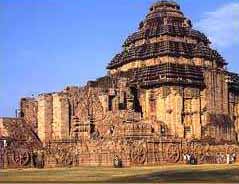 Puri,
the magnificent beach resort of Orissa, is also one of the four great pilgrim centres of
India. Bhubaneshwar, the "city of temples" harking back to glories of the past.
Konark, lavish, monumental and all prevading, the crowning glory of Orissa - the
stupendous Sun Temple of Konark.
Puri,
the magnificent beach resort of Orissa, is also one of the four great pilgrim centres of
India. Bhubaneshwar, the "city of temples" harking back to glories of the past.
Konark, lavish, monumental and all prevading, the crowning glory of Orissa - the
stupendous Sun Temple of Konark.
In Puri - visit Gundicha Mandir, and the several temples all of which come alive annually every June during Rath or the Car Festival. In Bhubneshwar, take in Parasurameshwara Temple, Rajrani Temple. In Konarak, make a trip to the Sun Temple.
| SRINAGAR |
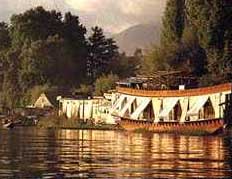 Srinagar is the capital of the State of Jammu
and Kashmir. Situated at 5,200 ft. above sea level and set amidst delightful surroundings,
it is, in many respects one of the finest pleasure resorts of the world. It is also
surrounded by beautiful lakes and gardens.
Srinagar is the capital of the State of Jammu
and Kashmir. Situated at 5,200 ft. above sea level and set amidst delightful surroundings,
it is, in many respects one of the finest pleasure resorts of the world. It is also
surrounded by beautiful lakes and gardens.
City sightseeing of Srinagar includes a drive through narrow lanes and bazzars, visiting Jumma Masjid, Shah Hamadan Mosque (700 years old), and drive past Moghul fort and Hari Parbat. Only a few miles from the city are the famous MOGHUL GARDENS of Chasma Shahi or "the Royal Springs",Nishat Bagh or "Garden of Pleasure" and Shalimar or the "Abode of Love". Framed against the background of the hills and commanding a fine view of the Lake the gardens are a feast of colour from spring to autumn. On the Dal Lake is the Naseem Bagh ‘Garden of Breezes’ - with its stately Chinar trees. Take a ‘Shikara’ (small paddle boat) ride over Dal Lake visiting Nehru Park, Kabutarkhana, Chaar Chinari Gardens and Floating Gardens and also visit a Carpet Weaving Centre.
GULMARG : Gulmarg, or the Meadow of Flowers, is one of the finest resorts in Kashmir. Lying at a height of 2591 m. (8,500 ft.) it is a golfer’s paradise and its upper course is reputed to be the best in Asia. A variety of snow covered slopes of Apharwat and Khilanmarg provide playgrounds for every type of winter sport such as king, tobaggonning, skating etc. Gulmarg is an excellent base for undertaking some of the most delightful and interesting treks.
SONMARG : 9000 ft. (2743 m.) above sea level Sonmarg is 80 kms. north-west of Srinagar and is reached by a motorable road which runs through the picturesque Sind Valley flanked on one side by densely populated slopes and on the other by many varieties of alpine flowrers. Sonmarg or "Golden Meadow" has an excellent base for undertaking some of the most delightful and interesting treks.
YUSMARG : Yusmarg (7840 ft.) is a small meadow and excellent picnic spot set in the heart of mountains to the southwest of Srinagar at a distance of 47 kms.
ACHABAL : This garden of Chinar groves, cascades and fountains, was one of the pleasure retreats of Queen Nur Jahan. Copious springs gush out of limestone rock on every side and there are a number of well preserved trout streams.
KOKERANG : Kokerang is famous for the curative properties of its beautiful sweetwater springs. There is a rose garden and fishing pools too, at Kokerang.
MANASBAL LAKE : A small but extremely pretty lake with a blue sheet of water surrounded by low hills and plateau. It is 29 kms. from Srinagar and lies enroute to Wular Lake. The abundance of yellow blossom, rapeseed fields and blue iris beds in spring give the lake an added enchantment.
WULAR LAKE : Wular Lake is one of the largest fresh water lakes in Asia. In early summer it measures almost 24 kms. across. The centre of the lake is unsafe for small boats in the afternoons when high winds rise and sweep down from the mountain without warning. The magnificient view of its stupendous grandeur can be had from Watlab.
AHARBAL FALLS : Aharbal Falls are 61 kms. from Srinagar via Shopan. The falls are impressive and the scenery picturesque.
| SHILLONG |
Situated at an altitude of 1500 mtrs. above the sea level, Shillong is an exquisite hill station nestling on a plateau of the Khasi and Jantia Hills of Assam
Visit the Secretariat, Raj Bhavan Ward, Lake, Bishop and Beadon Falls, the Gold Cup and of course the colourful bazar.
| TIRUCHIRAPALLI |
| TANJORE |
Tanjore or Thanjavur as it was earlier called, was the capital of the Chola Empire from the 10th century to the 14th century A.D. Later it became part of the Vijaynagar Kingdom, then passed into the hands of the Marathas and later still went to the British. For ages it has been the chief political, literary and religious centre of the south. The celebrated temple of Brihadeshwara built by the Chola King, Raja the Great, during the 11th century is its major attraction. The Saraswati Mahal Library, dating from the time of the Marathas, contains a rare collection of books and manuscripts on paper and palm leaves.
| TRIVANDRUM |
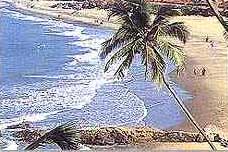 KOVALAM
BEACH : 14 kms. south of Trivandrum, is one of the
finest beaches in India. With its sheltered beach, Kovalam is endowed with unusual beauty.
It is deal for sea bathing and is safe even during the roughest weather. The scenery
around is enchanting and the drive to the beach through palm groves, refreshing.
KOVALAM
BEACH : 14 kms. south of Trivandrum, is one of the
finest beaches in India. With its sheltered beach, Kovalam is endowed with unusual beauty.
It is deal for sea bathing and is safe even during the roughest weather. The scenery
around is enchanting and the drive to the beach through palm groves, refreshing.
PADMANABHAPURAM : 53 kms. (33 miles) south of Trivandrum, is one of the ancient capitals of the former state of Travancore. In the old palace there are mural paintings of a high order. It contains relics of historical and artistic value.
(Closed on Mondays).
74 kms. from Trivandrum, SUCHINDRM temples contain beautiful carvings and sculptures.
CAPE COMORIN (KANYAKUMARI) : Kanyakumari is the land’s end of India and its tapering end meet three seas - The Bay of Bengal, the Arabian Sea and the Indian Ocean. One can see the sun rise from the Bay of Bengal and set in the Arabian Sea. Kanyakumari Temple, the Gandhi Samarak Mandir and Vivekananda Rocks are worth visiting. Boat rides to Vivekananda Rock Memorial are organised twice daily, in the morning and in the afternoon.
UDAIPUR |
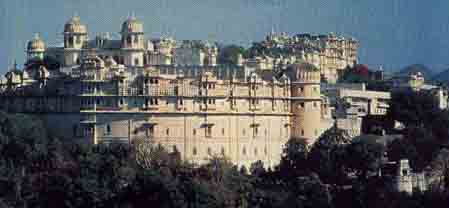 In Udaipur the visitor finds his dream of India come true, for
the city combines real beauty with picturesque associations of a great and glorious pat.
It stands in a valley, amid green hills on the banks of wide, steel-blue Lake Pichola. On
little islands in the lake, from the water’s edge, rise marble palaces of pure white
that glisten like fairy castles. Crowning the ridge, in which the city clusters, along the
shores of the lake is the palace of the Maharana. Within the palace is all the
magnificience of the East - peacocks in mosaic on the walls, floors inlaid with tiles of
rare beauty, and roof gardens affording thrilling views of the panorama below. Sightseeing
of Udaipur includes visits of Sahelion Ki Bari, drive around Fateh Sagar Lake, City
Palace, Jagdish Temple and Gulab Niwas Garden.
In Udaipur the visitor finds his dream of India come true, for
the city combines real beauty with picturesque associations of a great and glorious pat.
It stands in a valley, amid green hills on the banks of wide, steel-blue Lake Pichola. On
little islands in the lake, from the water’s edge, rise marble palaces of pure white
that glisten like fairy castles. Crowning the ridge, in which the city clusters, along the
shores of the lake is the palace of the Maharana. Within the palace is all the
magnificience of the East - peacocks in mosaic on the walls, floors inlaid with tiles of
rare beauty, and roof gardens affording thrilling views of the panorama below. Sightseeing
of Udaipur includes visits of Sahelion Ki Bari, drive around Fateh Sagar Lake, City
Palace, Jagdish Temple and Gulab Niwas Garden.
BOAT RIDE ON LAKE PICHOLA : Visit the Jag Niwas Palace by motor launch. The palace, built of granite and marble, covres four acres and is built almost in the middle of the lake. Visit the Borra Mahal, Khas Mahal and the Courts, Gardens and Fountains. Also visit Jag Mandir Palace.
EXLINGJI : About 23 kms. from Udaipur, and linked by a motor road that runs through splendid scenery and a mountain pass is Eklingji, a magnificient temple dedicated to Lord Shiva.
NAGDA : Very close to Eklingji is Nanda, named after its founder Nagaditya and is one of the most ancient places in Mewar. There are Hindu and Jain Temples, notable among which is the Sas-Bahu Temple dedicated to Vishnu.
RANAKPUR : 160 kms from Udaipur, in a quiet isolated glen, is a remarkable complex of Jain Temples of Ranakpur (1440 A.D.). Built during the regin of the liberal and gifted monarch Rana Khumba, these temples, though belonging to a late period (15th Century), when the peak of the claasical age was already past, are a unique example of Jain ecclesiastical architecture. The entire enclosure is encircled by a wall. One temple consists of 29 halls and 426 pillars full of sculptural decoration. No two pillars are alike here.
JAISAMAND : 57, kms. southeast of Udaipur is Jaisamand, one of the largest artificial sheets of water in the world and built by Maharana Jai Singh. The lake area is full of wildlife and is rich in deer, wild boar and panther. A watch tower on the top of a hillock is excellent for watching wildlife.
RAJASAMAND : On the way of Kumbalgarh, stop at Kankroli to visit the magnificient dam built by Rana Sanga in 1660. This is Rajasamand - the royal lake. A high massive masonry dam stretches all along the bank of the lake. The terrace is paved with marble. There are ornamental toranas or arches and chhatris are interspersed all along the embankment.
| VARANASI (BANARAS) |
To the Hindus, Varanasi, sprawling along the left bank of the river Ganga,
SARNATH : Eight kms. (5 miles) north of Varanasi is Sarnath, where, in the Deer Park, Gautam Buddha delivered his first sermon after he became the ‘Enlightened One’. The ruins of monasteries, built more than 2000 years ago, the Dhamok Stupa, the Dharmaraji Ka Stupa and the main shrine draw Buddhist pilgrims yearly to Sarnath. The Mahabodhi Society of India have recently built a modern Vihara, the interior of frescoes of which have been executed by a Japanese artist. At Sarnath stands the famous Ashoka Pillar of polished sandstone whose lion capital has been adopted by the Republic of India as its state emblem. The museum (closed on Fridays) designed like a Buddhist monastery, contains many superb specimens of ancient art.
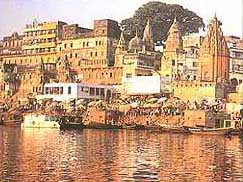 GANGES BOAT RIDE :
Drive through the city to the sacred River Ganges and visit by boat the Bathing Ghats,
Observatory, Nepalese Temple (Temple of Love). Cremation Ghats and Aurangzeb’s
Mosque. Return to Desasswamedh Ghat and thence back to the hotel.
GANGES BOAT RIDE :
Drive through the city to the sacred River Ganges and visit by boat the Bathing Ghats,
Observatory, Nepalese Temple (Temple of Love). Cremation Ghats and Aurangzeb’s
Mosque. Return to Desasswamedh Ghat and thence back to the hotel.